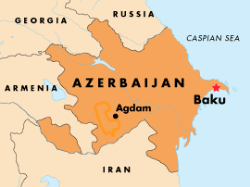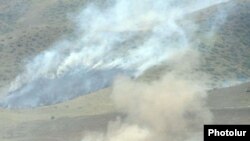Azerbaijan said one of its soldiers was killed early on March 7 near the ceasefire line that separates Azerbaijani and Armenian forces.
Armenian forces said one of their men had been killed in a separate clash last week.
Both sides blamed the other for triggering the latest exchanges of fire.
The two countries are in a dispute over Nagorno-Karabakh, a mostly ethnic Armenian enclave which split from Azerbaijan in a war in the early 1990s. A 1994 cease-fire ended the fighting but the status of the enclave remains unresolved.
Tensions have been rising since talks in France between the Armenian and Azerbaijani presidents last month in France failed to deliver progress.
(AP, Turan, Reuters)
The Nagorno-Karabakh Conflict
 Click on the image to view an enlarged map of the Nagorno-Karabakh conflict zone
Click on the image to view an enlarged map of the Nagorno-Karabakh conflict zone
In February 1988, the local assembly in Stepanakert, the local capital of the Azerbaijani region of NAGORNO-KARABAKH, passed a resolution calling for unification of the predominantly ethnic-Armenian region with Armenia. There were reports of violence against local Azeris, followed by attacks against Armenians in the Azerbaijani city of Sumgait. In 1991-92, Azerbaijani forces launched an offensive against separatist forces in Nagorno-Karabakh, but the Armenians counterattacked and by 1993-94 had seized almost all of the region, as well as vast areas around it. About 600,000 Azeris were displaced and as many as 25,000 people were killed before a Russian-brokered cease-fire was imposed in May 1994.
CHRONOLOGY: For an annotated timeline of the fighting around Nagorno-Karabakh in 1988-94 and the long search for a permanent settlement to the conflict, click here.
 Click on the icon to view images of the Nagorno-Karabakh conflict (Flash required)
Click on the icon to view images of the Nagorno-Karabakh conflict (Flash required)
To view an archive of all of RFE/RL's coverage of Nagorno-Karabakh, click here.














